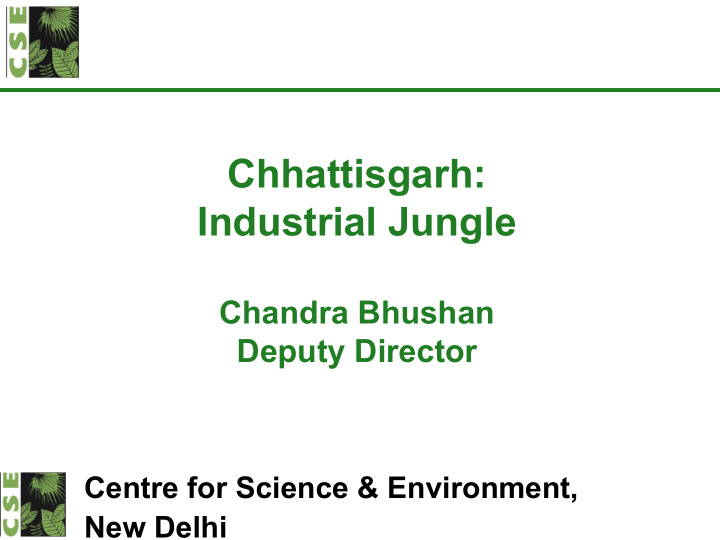



Chhattisgarh: Industrial Jungle Chandra Bhushan Deputy Director Centre for Science & Environment, New Delhi
Chhattisgarh industries:A glance About 200 large industrial units are present in Chhattisgarh and scores of small units Over 200 mining projects Present industries include iron and steel plants, sponge iron, cement, thermal power plants, mines, etc. 700 plants to come up in the state
The Rush Seventy six projects have been cleared in the state by the Ministry of Environment and Forests (MoEF) since 2007 Thermal power plants 14 Mining 26 Cement plants 7 Steel plants 22 Other industries 3 Miscellaneous 4 TOTAL 76
The Rush 138 have been granted Terms of Reference (ToR) by MoEF Thermal power plants 42 Biomass based thermal power 4 plants Mining 39 Steel plants 36 Cement plants 4 Sponge iron 7 Other industries 6 TOTAL 138
The Rush The state government has signed 115 MoUs with proposed investment of Rs. 1,76,193 crore Each MoU is a group of projects taking the total to 543 projects Total 745 projects are planned in Chhattisgarh: which include those granted clearance, those granted ToRs and those for which MoUs have been signed
Big Numbers Present coal based thermal power capacity in the state is 12 per cent of the country's current coal based power capacity Plans to add 65 per cent of India's current coal based power capacity
Big Numbers
Big Numbers The present sponge iron capacity in Chhattisgarh is 7 per cent of India's present capacity The state's planned sponge iron capacity will equal India's present capacity Chhattisgarh also has India's 6 per cent cement capacity at present Plans to add cement capacity equalling 51 per cent of India's present capacity
Big Numbers
Resource requirement Annual water requirement of all the 745 projects is estimated at 3,000 mcm Quantity sufficient to meet the domestic water requirements of 274 million people – 13 times the population of Chhattisgarh Land requirement is 1,15,000 hectare (ha) Coal requirement for the thermal power capacity addition will be 311 MTPA
Thermal Power About two-thirds of the planned coal based thermal power capacity is in just two districts – Raigarh and Janjgir-Champa Raigarh will have 37 per cent of this planned capacity and Janjgir will get 34 per cent of it
Janjgir-Champa Present coal based thermal capacity - 121 MW Planned capacity - 19,000 MW Four thermal power plants cleared and 13 are in pipeline Fourteen MoUs for 62 project signed by the state government for Janjgir-Champa worth Rs. 22,586 crore – twelve of these are thermal power plants
Janjgir-Champa Estimated land requirement for these 62 projects - 13,000 ha Water requirement estimated at 700 million cubic metre (mcm) per year. Thermal plants alone will draw 660 mcm of water Dabhra block is a special case with 9 planned thermal power plants within a radius of 10 kilometres (km)
Raigarh Raigarh has 53 large and 37 small industrial plants at present Present coal based thermal power capacity - 1,420 MW Planned power capacity - over 20,000 MW Fourteen power plants are in the cleared or pipeline stage MoUs have been signed with 28 companies for 188 projects with an investment of Rs. 61,494 crore – 30 are for thermal power plants
Raigarh Estimated land requirement for all the planned projects in the district is about 30,000 ha Water requirement is estimated at 980 mcm per year. Thermal plants alone will draw 700 mcm
Land: acquisition and compensation Land acquired through the government or through private negotiations with land owners Government process based on classifying agricultural land as single crop, double crop or barren. Compensation dependent on the category Compensation rates revised in March: Rs. 10 lakh per acre (0.4 ha) for double crop irrigated, Rs. 8 lakh an acre for single crop un-irrigated land and Rs. 6 lakh an acre for barren land.
Land: Forests About 13,000 ha of forestland has been diverted to industry in Chhattisgarh since 2000 Of this, 97 per cent for mining Proposals for diversion of another 13,000 ha of forestland are pending Another 7,000 ha of forestland has ongoing mineral prospecting
Mahanadi in peril Of the 118 projects, with available data on water sourcing, 33 plan to withdraw water from the Mahanadi – 1,500 mcm per year Thermal power plants will withdraw 1,500 mcm every year from the river Water withdrawal will go up to 2,700 mcm if sourcing from Mahanadi's tributaries – Hasdeo, Lilagarh and Seonath, is added
Mahanadi in peril Total water withdrawal from Mahanadi (including existing projects): 3,700 mcm Dependable water availability in the Mahanadi over the last 10 years - an average of 1,528 mcm (measured at Kasdol) With industry set to withdraw 3,700 mcm, water budget likely to be in deficit
Cumulative impact Cumulative assessment of this industrialisation is imperative For example, Dabhra block has 9,000 MW of planned thermal power capacity A thermal power plant on an average generates about 300 kilogram (kg) of flyash and 3kg of Suspended Particulate Matter (SPM) per mega Watt hour of generation The nine power plants put together will generate about 21 million tonnes of flyash and 0.2 million tonnes of SPM
Cumulative impact As per the Comprehensive Environmental Pollution Index (CEPI), Korba is the fifth most polluted district in the country Raipur and Bhilai-Durg are also severely polluted New projects on hold for these districts Does Chhattisgarh have a method in place to assess such cumulative impact and address critical pollution levels?
Recommend
More recommend